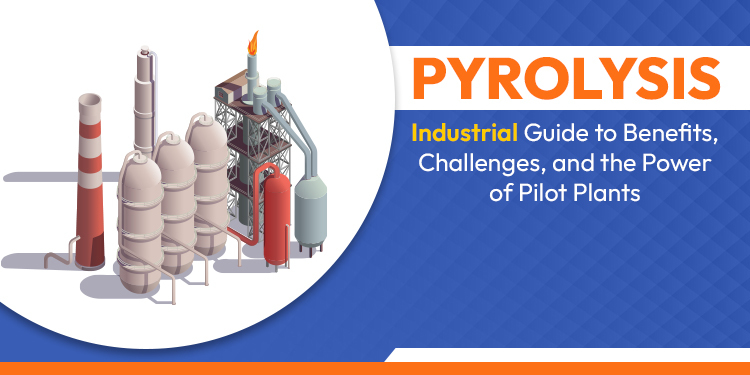Premier Pilot Plant People

Pyrolysis: Industrial Guide to Benefits, Challenges, and the Power of Pilot Plants
Pyrolysis: Industrial Guide to Benefits, Challenges, and the Power of Pilot Plants
What is Pyrolysis?
Pyrolysis is a controlled, high-temperature process (typically between 350°C to 700°C) where organic or synthetic materials are thermally decomposed in the absence of oxygen. Unlike combustion, where oxygen feeds the flame, Pyrolysis isolates the feedstock in a sealed environment, breaking down complex polymers and biomass into syngas, bio-oil, and char.- Feedstock Examples: Plastic waste, biomass, municipal solid waste, rubber, industrial sludge.
- Typical Outputs:
- Gas: 20–30% yield, usable as fuel gas.
- Liquid (Bio-oil): 35–50% yield, usable in boilers or refining.
- Solid (Char): 20–30% yield, useful as activated carbon or soil additive.
Benefits of Pyrolysis
Pyrolysis isn’t just a scientific curiosity; it delivers tangible industrial value:- Up to 90% Waste Volume Reduction: Drastically cuts down on landfill use and associated costs.
- Energy Efficiency: The syngas produced can achieve calorific values of 16–20 MJ/kg, making it a potent fuel substitute.
- Resource Recovery:
- Carbon black reclaimed from tire pyrolysis has a market value of $0.40–0.60 per kg.
- Bio-oil can be further processed to replace diesel in industrial boilers.
- Environmental Compliance: Helps industries meet tightening regulations on landfill diversion and carbon emissions.
- Circular Economy Integration: Transforms linear waste streams into circular resource flows, improving overall material efficiency.
Industrial Uses of Pyrolysis
Across sectors, Pyrolysis has carved out a critical role:- Plastic Recycling: With over 400 million tons of plastic waste generated globally each year, Pyrolysis offers a scalable recycling method, recovering monomers and fuel.
- Tire Pyrolysis: The global market for pyrolysis oil from tires is projected to reach $550 million by 2027, highlighting its commercial viability.
- Biomass Conversion: Agricultural waste conversion rates of up to 50% bio-oil yield help rural industries monetize biomass.
- Oil and Gas Industry: Enhances low-grade feedstock valorization, improving overall refinery economics.
- Hazardous Waste Management: Safely breaks down contaminated materials, reducing environmental liabilities.
Pyrolysis Challenges
Despite its promise, Pyrolysis involves complexities that industries must navigate:- Feedstock Sensitivity: Moisture content exceeding 10–15% can lower output quality and energy efficiency.
- Process Optimization: Reactor design, residence time, and heating rates significantly affect product yield and quality.
- Gas Handling: Pyrolysis gases contain volatile compounds, requiring robust condensation and scrubbing systems.
- High Initial Capital Costs: Commercial-scale plants demand significant upfront investment, typically ranging from $3 million to $10 million.
- Regulatory Approvals: Managing emissions and by-products requires compliance with stringent environmental regulations.
Pyrolysis System Requirements
For successful implementation, a Pyrolysis system requires:- Consistent Feedstock Preparation: Size reduction and moisture control below 15% moisture content.
- Advanced Reactor Design: Options like fixed-bed, fluidized-bed, or rotary kiln reactors, selected based on throughput needs.
- Efficient Heat Transfer Mechanisms: To maintain uniform temperature profiles and avoid feedstock charring.
- Product Recovery Systems: Multi-stage condensers, gas scrubbers, and char collectors.
- Automated Control Systems: Real-time monitoring for temperature, pressure, and gas composition to ensure operational stability.
How Pilot Plants Help in Pyrolysis Success
Before full-scale implementation, pilot plants play an indispensable role. They are not just test platforms, they are critical learning grounds.- Process Validation: Simulate real-world operations and fine-tune process parameters without the risks of large-scale failures.
- Feedstock Versatility Testing: Pilot plants allow manufacturers to test multiple feedstocks and blends, accurately predicting yields and output quality.
- Economic Feasibility Analysis: Helps project actual throughput, energy consumption, and product marketability before scaling.
- Data Generation: Generates valuable performance data for engineering design, regulatory submissions, and investor pitches.
- Risk Mitigation: Identifies potential bottlenecks, safety issues, and emission challenges at an early stage.
Partnering with Xytel India for Your Pyrolysis Pilot Plant
At Xytel India, we bring decades of engineering expertise to help industries transition from concept to commercial-scale Pyrolysis operations. Our bespoke pilot plant solutions enable manufacturers to test process variables, optimize feedstock handling, and validate product outputs in a controlled, data-rich environment. From system design to commissioning, we ensure that every pilot plant is tailored to meet your operational needs, compliance standards, and commercial objectives. Explore how we can help turn your Pyrolysis vision into a practical, scalable, and profitable reality.Get in Touch
You will be amazed as how partnering with us becomes a game changer in your quest for R&D glory.

 Call Us
Call Us